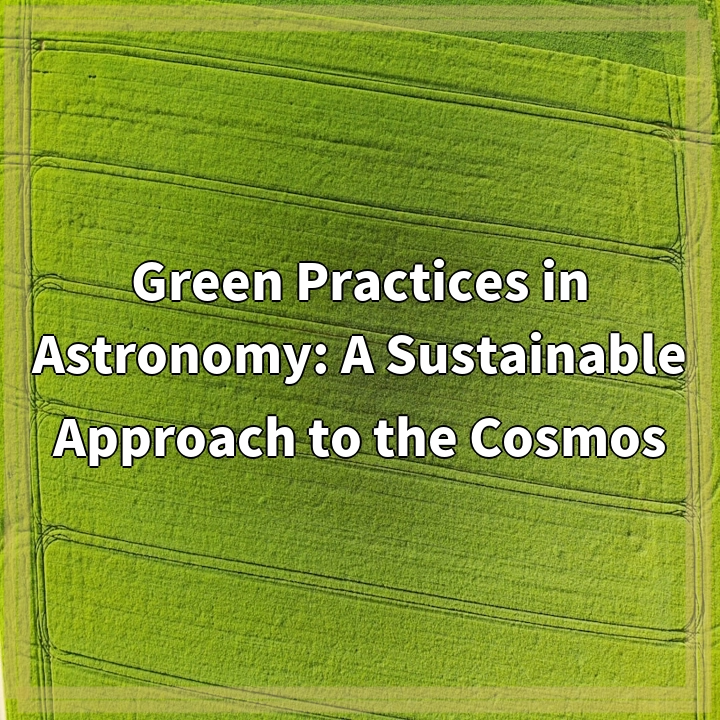
What it is:
Green Practices in Astronomy refer to the initiatives and methods adopted by astronomers and institutions to minimize the environmental impact of astronomical research and exploration. As the field of astronomy expands, the need for sustainable practices becomes increasingly urgent. This encompasses a range of actions, from energy-efficient observatories to the use of eco-friendly materials for telescopes and equipment. Promoting sustainability in astronomy not only benefits the planet but also ensures that the night sky remains accessible for future generations of researchers and enthusiasts.
Key Aspects of Green Practices in Astronomy
Green practices in astronomy involve several key areas, including:
- Utilization of renewable energy sources for observatories and research facilities.
- Implementing energy-efficient technologies and practices to reduce power consumption.
- Designing telescopes and observational instruments that have minimal ecological impacts.
- Engaging in conservation efforts to protect pristine night skies from light pollution.
- Investing in eco-friendly transportation methods for research expeditions.
Real-world Problems
As astronomy continues to grow, it faces several real-world problems related to environmental sustainability:
Light Pollution
Light pollution significantly hinders astronomical observations by obscuring celestial objects and altering natural ecosystems. As urban areas expand, excessive artificial lighting affects not only astronomers’ ability to study the night sky but also disrupts wildlife behavior, plant growth, and human circadian rhythms.
Energy Consumption
Traditional telescopes and observatories often consume substantial amounts of energy, primarily derived from fossil fuels. This not only contributes to greenhouse gas emissions but also places a strain on local energy resources. Transitioning to renewable energy sources is essential for decreasing the carbon footprint associated with astronomical research.
Resource Utilization
The production and disposal of astronomical equipment and materials can lead to considerable waste and resource depletion. Inefficient manufacturing processes and reliance on non-renewable resources contribute to environmental degradation. Implementing sustainable sourcing and recycling practices is crucial for mitigating these impacts.
Accessibility and Equity
Disparities in access to astronomical research and education can hinder progress in sustainability. Many developing regions lack the resources or infrastructure to engage in green practices effectively. Promoting equity in astronomy ensures that all communities can participate in sustainability efforts and benefit from advancements in the field.
Climate Change
Climate change poses a direct threat to astronomical observation. Increased atmospheric instability, changes in weather patterns, and rising temperatures can compromise the efficacy of telescopes and observational techniques. Addressing climate change is vital for ensuring the future of astronomical research and preserving the integrity of the night sky.

Solutions for Green Practices in Astronomy
To address the environmental challenges faced by the field of astronomy, a range of innovative solutions can be implemented. These solutions aim to promote sustainability while enhancing the quality of astronomical research and observations.
Reducing Light Pollution
Implementing community-focused initiatives to reduce light pollution can significantly improve astronomical visibility. This includes promoting the use of shielding for outdoor lights, utilizing dimmable lighting, and promoting awareness about the importance of dark skies for both ecological and astronomical purposes.
Transitioning to Renewable Energy
A key solution involves transitioning energy sources at observatories and research facilities from fossil fuels to renewable options such as solar, wind, and hydropower. Investment in energy-efficient technologies like LED lighting and smart energy management systems can further reduce overall energy consumption while maintaining effective research capabilities.
Implementing Sustainable Manufacturing
Adopting sustainable manufacturing processes for astronomical instruments and equipment can mitigate resource depletion and waste generation. This includes using environmentally friendly materials, embracing recycling programs, and developing technologies that minimize the environmental footprint throughout their lifecycle.
Enhancing Accessibility and Equity
To ensure that all communities benefit from green practices in astronomy, partnerships between established institutions and developing regions should be fostered. This can involve sharing resources, providing training, and promoting technological access to empower underrepresented communities in participating in sustainability efforts.
Confronting Climate Change
Collaboration among astronomers, policymakers, and environmental scientists is essential in addressing the impacts of climate change on astronomical research. Advocating for climate-friendly policies and engaging in conservation initiatives will help protect the integrity of both natural ecosystems and the night sky.















